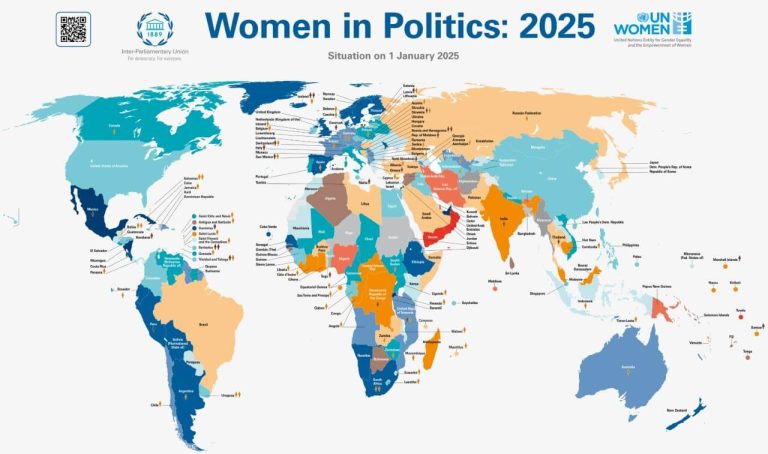The president of IPU, Tulia Ackson, said: “The ice rate of progress in the parliamentary representation of women, even after a year of important elections, is alarming. The global disparity highlights a systemic failure to advance gender equality in politics in certain parts of the world. It is high time for a decisive action to break these barriers and to ensure that women ‘voices are also represented in politics in the world. The health of our democracies depends on it. »»
Martin Chungong, secretary general of IPU, said: “The lack of progress in achieving gender equality in political leadership serves as an appeal to action that gives to think. The acceleration of progress requires active participation and support of men. It is our collective responsibility to decompose obstacles and ensure that women’s voices are also represented in leadership roles, promoting a more inclusive and robust democracy for all. »»
Sima Bahous, executive director of the United Nations, said: “Thirty years after the Beijing Declaration, the promise of gender equality in political leadership is not carried out. Progress is not only slow – it’s behind. We cannot accept a world where half of the population is systematically excluded from decision -making. We know the solutions: quotas, electoral reforms and political will to dismantle systemic barriers. The time for half -measures is over – it is time for governments to act now to ensure that women have an equal seat at each table where power is exercised. »»
Leading women remain the exception
Women occupy high -level positions in only 25 countries. Europe remains the region with the greatest number of countries led by women (12).
Although 2024 saw first historicals – including the first women presidents directly elected in Mexico, Namibia and northern Macedonia – 106 countries have always had a leader.
The representation of women among the ministers of the cabinet decreases
On January 1, 2025, the proportion of women at the head of ministries decreased to 22.9%, against 23.3% a year ago. This drop is due to 64 countries noting a decrease in the representation of women at this level and 63 other stagnation, with only 62 increasing a year ago.
Only nine countries, mainly in Europe, have reached equal cabinets, with 50% or more women occupying cabinet posts as heads of ministries. These are Nicaragua (64.3%), Finland (61.1%), Iceland and Liechtenstein (60%), Estonia (58.3%) and Andorra, Chile, Spain and the United Kingdom (all at 50%). This represents a drop compared to 2024, when 15 countries had equal cabinets.
There are 20 additional countries where the representation of women among the ministers of the cabinet varies between 40% and 49.9%, with half of these countries in Europe. Nine countries, mainly in Asia and the Pacific, have no women as a cabinet ministers, an increase in seven countries in 2024.
Europe and North America (31.4%) and Latin America and the Caribbean (30.4%) have the highest actions of the women’s ministers.
On the other hand, women are considerably under-represented in most other regions, with regional figures as low as 10.2% in the Pacific Islands (excluding Australia and New Zealand) and 9% in Central Asia and South Asia.
Ministerial portfolios continue to undergo sexist prejudices
The allowance of ministerial portfolios highlights continuous gender prejudice. Women are still mainly assigned to the political areas to the head concerning gender equality, human rights and social affairs. The most influential political areas, such as foreign affairs, financial and tax affairs, domestic affairs and defense, are largely controlled by men.
| Ministerial portfolio | % women |
|---|---|
| Women and gender equality | 86.7 |
| Family and children’s business | 71.4 |
| Inclusion and social development | 55.6 |
| Social protection and social security | 42.1 |
| Foreign affairs | 17.8 |
| Financial and tax affairs | 16.4 |
| Interior affairs | 13.2 |
| Defense | 13.0 |
Although still underrepresented, new data show more women at the head of other important political portfolios, such as culture (35.4%), education (30.6%) and tourism (30.5%).
Women’s growth in parliament stands
The card follows the publication of the IPU “Women in Parliament” annual report, which revealed that, although 2024 was a great electoral year, progress towards women’s representation has been slowest since 2017.
The data also reveals significant regional disparities:
- The Americas have the largest proportion of women deputies (34.5%) and women speakers in the parliament (33.3%).
- Europe comes second with 31.8% of MPS women and 30.4% of speakers.
- The region of the Middle East and North Africa is placed last, women occupying only 16.7% of parliamentary seats and currently no woman speakers in the Parliament.
In a rare light point, the total number of women speakers increased to 64 on 270 positions, reaching 23.7%, against 22.7% in 2023 (62 out of 273).
And assistant women speakers now represent 32.6% of the total, compared to 28.9% in 2023.
The new “Women in Politics” women’s card was presented during the 69th commission session on women’s statusThe largest UN gathering on gender equality.


